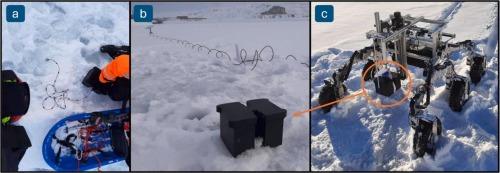温度串仪(TSD):一种用于偏远地区海冰观测的新型低成本仪器
IF 2.1
Q3 ENGINEERING, ELECTRICAL & ELECTRONIC
引用次数: 0
摘要
北极地区气候变暖导致海冰融化。海冰在反射太阳辐射、减少热量吸收和减缓温度上升方面发挥着关键作用。然而,在气温上升的推动下,每年海冰形成的减少促成了一个加速进一步变暖的正反馈循环。这强调了监测季节性海冰增长的重要性。为了满足这一需求,开发了一种温度串装置。这种创新的、低成本的、紧凑的、可定制的解决方案是为易于部署而设计的,只需要一个人,甚至一个机器人就可以进行非人工部署。该设备测量整个海冰的温度,并将数据实时传输到云端,从而可以立即分析估算海冰厚度。它的默认配置是每隔30分钟收集3米深度的30个数据点,并保持运行长达一年。其可负担性允许生产多个单元,从而实现广泛部署并提高空间分辨率。此外,它对机器人部署的适用性使其成为远程,难以接近的位置的理想选择,便于同时监控。本文章由计算机程序翻译,如有差异,请以英文原文为准。

Temperature string device (TSD): A new low-cost instrument for sea ice observations in remote areas
Warmer conditions in the Arctic regions are causing sea ice to melt. Sea ice plays critical roles in reflecting solar radiation, mitigating heat absorption and slowing temperature rise. However, the reduction in annual sea ice formation, driven by rising temperatures, contributes to a positive feedback loop that accelerates further warming. This underscores the importance of monitoring seasonal sea ice growth. To address this need, a Temperature String Device has been developed. This innovative, low-cost, compact, and customizable solution is designed for easy deployment, requiring just one person or even a robot for non-human deployment. The device measures temperature throughout the sea ice and transmits data in real-time to the cloud, enabling immediate analysis to estimate sea ice thickness. Its default configuration collects 30 data points over a 3-meter depth at 30-minute intervals and remains operational for up to one year. Its affordability allows production of multiple units, enabling widespread deployment and enhancing spatial resolution. Furthermore, its suitability for robotic deployments makes it ideal for remote, inaccessible locations, facilitating simultaneous monitoring.
求助全文
通过发布文献求助,成功后即可免费获取论文全文。
去求助
来源期刊

HardwareX
Engineering-Industrial and Manufacturing Engineering
CiteScore
4.10
自引率
18.20%
发文量
124
审稿时长
24 weeks
期刊介绍:
HardwareX is an open access journal established to promote free and open source designing, building and customizing of scientific infrastructure (hardware). HardwareX aims to recognize researchers for the time and effort in developing scientific infrastructure while providing end-users with sufficient information to replicate and validate the advances presented. HardwareX is open to input from all scientific, technological and medical disciplines. Scientific infrastructure will be interpreted in the broadest sense. Including hardware modifications to existing infrastructure, sensors and tools that perform measurements and other functions outside of the traditional lab setting (such as wearables, air/water quality sensors, and low cost alternatives to existing tools), and the creation of wholly new tools for either standard or novel laboratory tasks. Authors are encouraged to submit hardware developments that address all aspects of science, not only the final measurement, for example, enhancements in sample preparation and handling, user safety, and quality control. The use of distributed digital manufacturing strategies (e.g. 3-D printing) is encouraged. All designs must be submitted under an open hardware license.
 求助内容:
求助内容: 应助结果提醒方式:
应助结果提醒方式:


